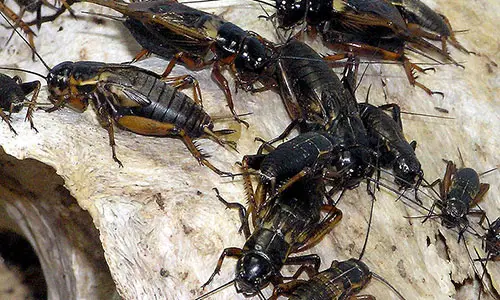1. Physical Features
Crickets are large to medium-sized insects that have chewing mouthparts. Like katydids and grasshoppers, they have back legs that are stronger and larger than the other two pairs. Their heads are rounded and they have a pair of thin long antennae called feelers. Cricket wings are bent-down on their body sides. Their top side appears to be flat. Generally, crickets have a black or brown color with tree crickets having a green color and whitish wings.
2. Cricket Ears are on the Legs
Male and female crickets have their ears located on the legs. The ears appear as round smooth structures on the lower legs. Females have a round thin tube at the end of the abdomen called an ovipositor from which they lay eggs. Crickets use their feelers to detect prey movement. The wings of male crickets have special structures that enable them to chirp when they rub the front wings.
3. Cricket Species
Crickets belong to an insect order known as Orthoptera. There are more than 900 cricket species in the world. 120 of these species are found in the U.S. Cricket species are further divided into several groups depending on their habitat and morphology.
4. Habitation
Crickets are found on all parts of the world and are capable of surviving in different habitations such as rocky areas, forests, fields, meadows and caves. Some crickets have their habitations underground. However, some cricket species face uncertain future as a result of habitation loss. This is because crickets are not flying insects and they tend to disappear with their habitats. As a result, some cricket species are considered endangered.
5. A Sign of Good Luck
Crickets are well known for the song sounds they produce. However, only males can produce song. Crickets are considered a sign of good tidings. In the past, the Chinese considered crickets as pets. The size of a cricket largely depends on its species though generally, crickets measure one to two inches in length.
6. Compound Eyes
Crickets have compound eyes consisting of numerous lenses that enable them to visualize different pictures at a go. They are nocturnal insects that are most active at night. Though they have wings, crickets cannot fly and instead move over short distances by generating jerky moves.
7. Feeding
Crickets feed on plants and other animals. This makes them omnivorous insects. Their food includes different kinds of plant materials, fungi and insects. Their main predators are large spiders, lizards, frogs and turtles. In some parts of Asia, crickets are considered a delicacy for human beings.
8. Mating
Male crickets rub their wings that have toothed areas or comb like structures to generate a chirping sound that attracts females during mating. Males also produce particular kinds of chirps as a symbol of aggression to other males. Females lay eggs during autumn and incubate them over winter. The eggs hatch at the onset of spring.
9. Chirping and Temperature
The amount of chirping among male crickets depends on temperatures. The external temperature in Fahrenheit degrees can be determined by adding 37 to the count of chirps generated in 15 seconds. High temperature is linked to high numbers of chirps. However, some small cricket species do not chirp.
10. Metamorphosis in Crickets
Crickets go through an incomplete metamorphosis that features developmental stages namely egg, nymph and adult. As they grow, crickets molt and young insects appear like smaller versions of adult crickets. Crickets can live for a year in the wild. They communicate through scent, sound and touch. Crickets that do not chirp use touch and scent to communicate and find each other.











Leave a Reply